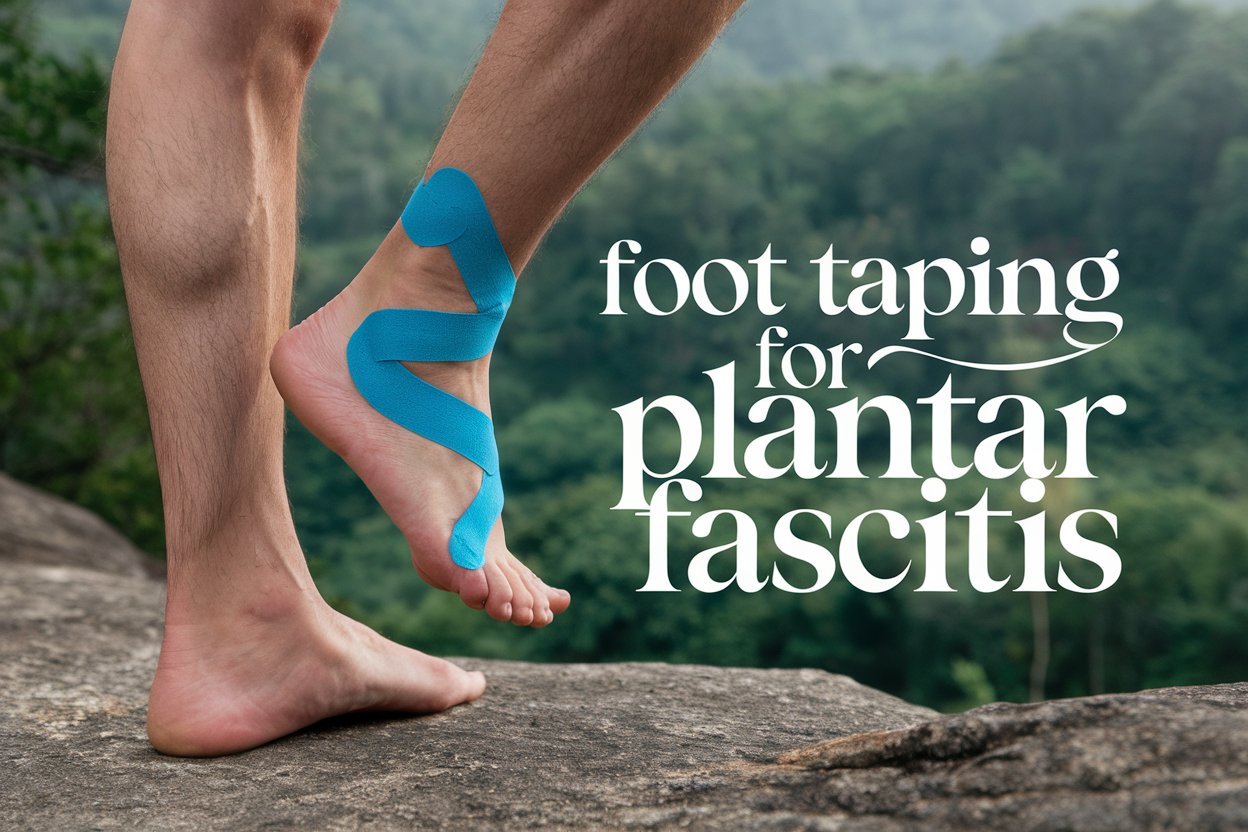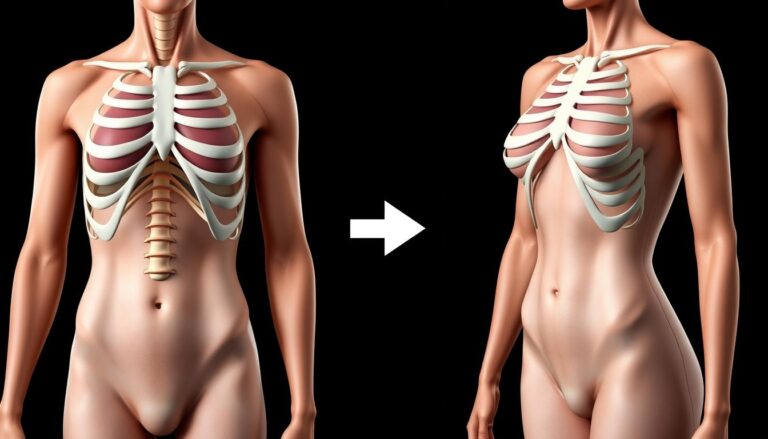Effective Foot Taping for Plantar Fasciitis Relief

Imagine waking up one morning, only to feel a sharp twinge of pain in your heel with every step you take. This is a common issue for those with plantar fasciitis. Many turn to taping as a way to find relief. A 2015 review showed that taping can help with pain, at least in the short term.
Learning how to tape your foot can ease discomfort and support it during daily activities. It’s great for anyone who loves to stay active or just wants to walk without pain. The right taping technique could be your ally in getting better.
This article will cover why taping helps with plantar fasciitis, how it works, and how to do it right. Let’s start this journey together, aiming for healthier, happier feet!
Table of Contents
Understanding Plantar Fasciitis
Plantar fasciitis is a common foot issue. It happens when the plantar fascia, a thick tissue at the foot’s bottom, gets inflamed. People with this condition often feel a lot of heel pain, especially when they first step out of bed or after sitting for a long time. It’s important to take good care of it to keep your feet healthy.
About 90% of people with plantar fasciitis get better in six months with treatment. Kinesiology tape is a popular way to help with the pain. It supports the plantar fascia, helps blood flow, and reduces swelling.
Using shoe inserts with taping can really help with plantar fasciitis pain. To make KT Tape work best, apply it without stretching at the anchor points. It’s important to rub the tape on your foot to make sure it sticks well.
Heel spurs, which are hard bumps on the heel bone, can make heel pain worse. Knowing about different ways to treat plantar fasciitis can help you find what works best. This can lead to a healthier and more active life.
| Treatment Method | Effectiveness |
|---|---|
| KT Tape Application | Good support and pain reduction |
| Shoe Inserts | Significant improvement when combined with taping |
| RICE Protocol | Effective for initial management |
| Stretching Exercises | Helps in long-term care |
| Ice Therapy | Reduces swelling |
What is the Plantar Fascia?

The plantar fascia is a key ligament that connects the heel to the toes. It helps support the arch of the foot. This tissue band absorbs shock and helps with walking and running.
When the plantar fascia gets too stressed, it can cause pain and inflammation. This is often seen in people who do a lot of high-impact activities or stand for long periods. These issues lead to micro-tears and pain, which is plantar fasciitis.
Knowing how the plantar fascia works helps in managing pain. New treatments like foot taping for plantar fascia support are now available. This method helps reduce pain and aid in healing. It’s known that almost 1 million people visit doctors each year for this issue.
Taping techniques, especially with kinesiology tape, can help support the plantar fascia. This method eases pain and shields the tissue from further harm. It also helps the healing process.
| Aspect | Details |
|---|---|
| Function | Supports the arch and absorbs shock during movement |
| Common Symptoms | Heel pain, especially after long periods of inactivity |
| Prevalence | Affects nearly 1 million patients seeking care annually |
| Taping Duration | Tape can remain on the foot for 3-4 days |
| Kinesiology Tape | Used for stress reduction and pain relief |
Causes of Plantar Fasciitis Pain
Plantar fasciitis is a common foot problem that affects many people. It’s especially common in active people between 40 and 70 years old. Women, especially during pregnancy, are more likely to get it due to changes in their body that put more stress on their feet.
There are several reasons why people get plantar fasciitis, including:
- Being overweight or obese
- Jobs that necessitate long periods of standing
- Structural abnormalities such as flat feet or high arches
- Tight Achilles tendons, limiting ankle flexibility
- Poor arch support in footwear
For athletes, the risk of getting plantar fasciitis is higher. Many runners, whether they’re serious athletes or just enjoy running for fun, can get this pain. About 10% of people will get plantar fasciitis at some point in their lives.
An MRI can show if the plantar fascia is inflamed or thickened. This helps doctors figure out why someone has plantar fasciitis. Knowing the risks can help people take steps to prevent it and keep their feet healthy.
| Risk Factor | Description |
|---|---|
| Body Mass Index >27 kg/m² | Being overweight or obese makes it more likely to get plantar fasciitis. |
| Prolonged Standing | Jobs that make you stand a lot can strain the plantar fascia. |
| Limited Ankle Dorsiflexion | Not being able to move your ankle fully can put more stress on the plantar fascia. |
| Poor Footwear | Shoes without good arch support can make plantar fasciitis worse. |
Symptoms of Plantar Fasciitis
It’s key to know the signs of foot pain from plantar fasciitis for good care. The symptoms of plantar fasciitis include sharp pain under the heel or on the foot’s sole. This pain gets worse when you first step out of bed or after resting.
Other signs you might see are:
- Stiffness in the foot, especially in the morning
- Swelling along the foot’s bottom
- Pain that gets worse during activity
- Discomfort after sitting or standing for a long time
Knowing the symptoms of plantar fasciitis helps you get treatment early. Often, taking care of yourself and trying simple treatments can fix it in a few months. Spotting these signs early means you can get help sooner and talk to a doctor when you need to.
| Symptom | Description |
|---|---|
| Sharp heel pain | Prominent during first steps upon waking or after prolonged sitting. |
| Stiffness | Especially in the morning or after periods of inactivity. |
| Swelling | Localized swelling can develop along the bottom of the foot. |
| Pain during activity | Pain may escalate during exercise or after standing for long durations. |
Why Foot Taping for Plantar Fasciitis Works
Foot taping for plantar fasciitis helps by stabilizing the plantar fascia. This limits movement that can make pain and inflammation worse. Taping the foot and ankle provides support and reduces strain during activities.
Mechanism of Action
The taping technique supports the foot’s natural arch and reduces pressure on the plantar fascia. It helps improve blood flow in the affected area, aiding healing. Many people find relief from chronic foot pain after using it. Kinesiology tape adds extra support, helping muscles around the foot work better.
Limitations of Motion
Foot taping aims to stop movements that irritate the plantar fascia. It helps reduce pain, making it easier to do activities without discomfort. Though tape offers temporary support, it shouldn’t replace other treatments like physical therapy or advice from experts like The Podiatry Group of South Texas.
| Feature | Kinesiology Tape | Athletic Tape |
|---|---|---|
| Flexibility | High | Low |
| Duration on Skin | 2 to 5 days | 1 to 3 days |
| Water Resistance | Yes | No |
| Effect on Circulation | Potentially improves | Minimally affects |
| Application Complexity | Moderate | Simple |
Benefits of Foot Taping
Foot taping brings many foot taping benefits that help manage plantar fasciitis. It reduces pain, making it easier to stay active. Let’s look at the key benefits of this treatment.
Relief from Pain and Discomfort
Foot taping helps ease pain and discomfort from plantar fasciitis right away. It keeps the foot stable and lessens strain on the plantar fascia. This means you can move more without feeling pain.
Many people find that foot taping cuts down on heel pain in their daily life. It makes moving around easier and more comfortable.
Support for the Arch of the Foot
Foot taping is key for supporting the arch of the foot. This is vital for those with flat feet or high arches. Such conditions can strain ligaments and tendons.
Using tapes like CureTape Classic or Art helps with plantar fasciitis support. It also lowers the chance of getting hurt. This support and stability helps heal and recover, making physical activities easier.
| Benefit | Description |
|---|---|
| Immediate Pain Relief | Reduces discomfort associated with plantar fasciitis by stabilizing the foot. |
| Arch Support | Provides essential support for individuals with flat feet or high arches. |
| Increased Activity Level | Allows users to engage in more physical activities with reduced pain. |
| Complementary Treatment | Serves as a beneficial addition to therapies like physical therapy or orthotic inserts. |
Materials Needed for Taping
Knowing what you need for foot taping is key to managing plantar fasciitis. Having the right plantar fasciitis taping supplies makes a big difference. The type of tape you use is crucial for support and easing pain.
Types of Tape Used
There are different tapes for foot taping. Let’s look at them:
- Zinc Oxide Tape: It’s stiff and lasts long, great for strapping.
- Kinesiology Tape: This tape is bendy and helps with blood flow. It might not help with pain as much as other tapes.
- Rigid Adhesive Tapes: Elastoplast and Leukotape are top choices for plantar fasciitis.
Where to Purchase Taping Supplies
It’s important to get good plantar fasciitis taping supplies. Here are some places to check out:
- Local sporting goods stores for a variety of tapes.
- Pharmacies have what you need, including kinesiology tape.
- Online shops like Amazon offer many products and reviews to help you choose.
| Type of Tape | Main Benefits | Where to Buy |
|---|---|---|
| Zinc Oxide Tape | Durable and supportive | Sporting goods stores, pharmacies |
| Kinesiology Tape | Flexible, promotes circulation | Online retailers, pharmacies |
| Rigid Adhesive Tape | Effective for strapping | Sporting goods stores, online retailers |
How to Prepare Your Foot for Taping
Getting your foot ready for taping is key to managing plantar fasciitis well. Start by cleaning your foot well. Use a non-moisturizing soap to get rid of oils and dirt. This makes sure the tape sticks better.
After cleaning, dry the area well. This step helps the tape stick and work right.
If your skin is sensitive or easily irritated, think about using a pre-wrap tape. It acts as a barrier, keeping the main tape away from your skin. This keeps the taping process safe for your skin.
Proper preparation is crucial for kinesiology tape to work well. Prepping your foot right not only helps the tape stick better but also relieves pain and supports your foot during daily activities. Always talk to a professional, like a physical therapist, to find the best approach for you.
Steps for Effective Foot Taping for Plantar Fasciitis
Effective foot taping can help ease the pain of plantar fasciitis. It stabilizes the foot and lessens strain on the plantar fascia. Here’s how to do it right.
Positioning Your Foot
Start by placing your foot in a neutral position. This setup is key for taping. Make sure your toes point straight ahead for best results. Proper positioning spreads your weight evenly, reducing pressure on the plantar fascia.
Applying the Tape
When taping for plantar fasciitis, follow these steps. Begin with tape around the foot’s ball. Then, add a strip at the heel, and finish with an X shape under the foot for support. Make sure the tape doesn’t compress too much. This method boosts blood flow and keeps support steady, helping with recovery.
| Step | Action | Purpose |
|---|---|---|
| 1 | Position foot neutrally | Maximize effectiveness and support |
| 2 | Wrap tape around the ball | Stabilize the forefoot |
| 3 | Attach a strip around the heel | Provide heel support |
| 4 | Create an X shape underfoot | Add extra support |
| 5 | Check for secure adhesion | Ensure effective treatment |
By following these steps, you can lessen heel pain and stay active while recovering from plantar fasciitis. Make sure all tape edges are pressed down well to avoid irritation.
Plantar Fasciitis Taping Techniques
Learning how to tape for plantar fasciitis can help ease pain. There are simple and complex ways to tape, each suited for different needs and injury levels. Using the right taping methods can lessen pain and help you move better.
A Basic Taping Technique Guide
A basic taping method involves wrapping tape around the foot’s ball and heel in an X-shape. This setup keeps the foot stable yet allows movement, which is good for everyday tasks. Using zinc oxide tape is popular because it sticks well and is comfy to wear, offering quick relief from pain.
Advanced Taping Methods
For more specific support, advanced techniques include using anchor strips and lateral support. These are great for athletes or those who put a lot of strain on their feet. Adding kinesiology tape can also help by reducing swelling and boosting blood flow. It’s important to know how to apply these tapes correctly to get the most out of them.
Using Kinesiology Tape for Plantar Fasciitis
Kinesiology tape is becoming popular for plantar fasciitis because of its special benefits. It’s different from traditional athletic tape. Kinesiology tape is stretchy and breathable, making it comfy for wearing a long time.
Differences Between Kinesiology and Athletic Tape
Both types of tape have their own uses in taping the foot. Here’s a look at what makes them different:
| Feature | Kinesiology Tape | Athletic Tape |
|---|---|---|
| Support Level | Flexible, allows movement | Rigid, restricts movement |
| Comfort | High, due to elasticity | Moderate, can be restrictive |
| Application | Easier, typically requires specific stretching percentages | More complex, involves cross straps and anchoring |
| Duration | Lasts 3-5 days | Typically lasts only during activity |
Application Tips for Kinesiology Tape
Here are some tips for applying kinesiology tape for plantar fasciitis:
- Use 2-inch wide strips of tape.
- Apply with the right tension. A light stretch of about 25% is often recommended for effective adherence.
- Make sure the skin is clean and dry before application.
- Start at the base of the toes and work towards the heel, laying the tape along the arch of the foot.
- Massage the tape gently after application to enhance adhesion.
Using kinesiology tape with other treatments helps manage plantar fasciitis. It can reduce pain and improve how well you can move. Proper taping techniques make healing faster and everyday tasks easier.
Frequency and Duration of Taping
Understanding how to tape for plantar fasciitis is key. It’s about knowing the right plantar fasciitis taping duration and foot taping frequency. Taping should match your activity level and needs for the best support.
It’s best to tape before any activity. This helps prevent strain and keeps the arch supported. Athletic tape is great for short-term use, but take it off at night to let your skin breathe.
Kinesiology tape can stay on for days, offering long-lasting support. This is good for recovery, especially if you need constant support. But, watch out for skin irritation and adjust the taping as needed to avoid problems.
| Tape Type | Application Duration | Usage Notes |
|---|---|---|
| Athletic Tape | Worn during physical activities; removed nightly | Provides immediate support but limits skin breathing |
| Kinesiology Tape | Can be worn up to several days | Offers prolonged support; check for skin irritation |
Having a clear plan for foot taping frequency and plantar fasciitis taping duration helps manage symptoms and supports foot health. Adjusting your plan based on how you feel will make it more effective. Finding the right balance helps you control your symptoms, leading to better health and more mobility.
When to Remove the Tape
Effective foot taping can help manage plantar fasciitis symptoms. It’s key to know when to take off the tape for foot taping care. You should remove athletic tape at night to let your skin breathe and heal. Leaving it on too long can cause irritation or discomfort.
Kinesiology tape can stay on until its adhesive weakens or if your skin gets irritated.
Removing foot tape regularly keeps your skin healthy and boosts the taping benefits. Watch your skin closely to avoid any bad reactions. Talking to a healthcare expert can help figure out the best taping and removal methods, especially for plantar fasciitis. For more on foot care and managing symptoms, check out this article on chiropractic care for plantar fasciitis.
| Type of Tape | Recommended Duration | Signs to Remove |
|---|---|---|
| Athletic Tape | Remove nightly | Irritation or discomfort |
| Kinesiology Tape | Until adhesion fades | Skin irritation |
Additional Treatments for Plantar Fasciitis Relief
Dealing with plantar fasciitis means using many different methods. Taping helps right away, but adding more treatments can help even more. This includes using special shoe inserts and doing exercises to make the foot muscles stronger and more flexible.
Combining Taping with Orthotic Inserts
Using shoe inserts with taping gives great support to the foot’s arch. These inserts lessen the strain on the plantar fascia. They are key in treating plantar fasciitis. You can buy custom or over-the-counter inserts, depending on your foot type and how you walk.
Physical Therapy and Exercises
Adding physical therapy to taping helps a lot. A therapist can suggest exercises to strengthen the calf and foot muscles. This can lessen pain and make walking easier. Doing stretches for the Achilles tendon and plantar fascia also helps a lot. For those looking at natural options, Ayurvedic treatments might also be helpful.
| Treatment Method | Description | Benefits |
|---|---|---|
| Taping | Support for the plantar fascia through adhesive tape. | Immediate pain relief and stabilization. |
| Orthotic Inserts | Cushioned supports for the arch of the foot. | Reduces strain and enhances comfort while walking. |
| Physical Therapy | Guided exercises specific to foot health. | Improves strength, flexibility, and reduces recovery time. |
Using these extra treatments with taping makes a strong plan for managing pain and healing. This approach often leads to better results. It helps people feel better and move freely again.
Common Mistakes to Avoid While Taping
Taping your foot for plantar fasciitis can help with pain, but some mistakes can make it less effective. One big mistake is putting too much tension on the tape. This can cause discomfort or skin irritation, making the pain worse.
It’s also important to clean and dry your foot before taping. If your foot is dirty or moist, the tape won’t stick well. This means it won’t support your foot as it should. Always make sure your foot is clean and dry before taping.
Don’t leave the tape on at night, especially if you’re using athletic tape. It can irritate your skin. Taking it off at night lets your skin breathe and stay healthy. Paying attention to these details will make taping your foot better.
Final Thoughts on Plantar Fasciitis Management
Managing plantar fasciitis means using a mix of good foot care, exercises, and taping. Studies show that custom treatment plans help people with chronic heel pain. For example, a study found that stretching the plantar fascia helped 68 people feel better.
It’s important to work with healthcare providers and keep track of your symptoms. Using NSAIDs and LowDye taping together has shown good results. This mix helps reduce pain and improve how well you can move.
To get better, stay informed and take an active role in your treatment. Check out credible resources for more on other treatments and recovery stories. Making your treatment plan fit your needs can lead to better results and help you overcome plantar fasciitis.
FAQ
What is plantar fasciitis?
How does foot taping help with plantar fasciitis relief?
What materials are needed for foot taping?
When should I apply the tape for plantar fasciitis?
What should I do to prepare my foot for taping?
Can foot taping replace other treatments for plantar fasciitis?
What are some common foot taping mistakes to avoid?
How can kinesiology tape differ from athletic tape in treating plantar fasciitis?







